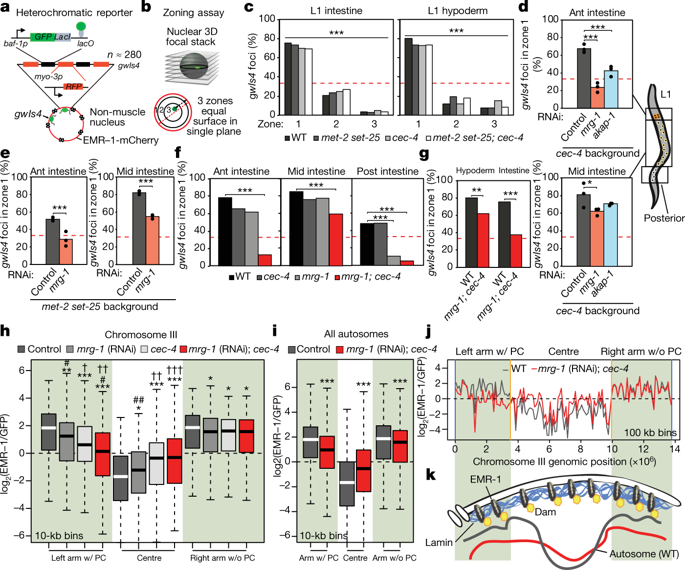Our official English website, www.x-mol.net, welcomes your
feedback! (Note: you will need to create a separate account there.)
Active chromatin marks drive spatial sequestration of heterochromatin in C. elegans nuclei
Nature ( IF 50.5 ) Pub Date : 2019-05-01 , DOI: 10.1038/s41586-019-1243-y Daphne S Cabianca 1 , Celia Muñoz-Jiménez 2 , Véronique Kalck 1 , Dimos Gaidatzis 1, 3 , Jan Padeken 1 , Andrew Seeber 1, 4, 5 , Peter Askjaer 2 , Susan M Gasser 1, 4
Nature ( IF 50.5 ) Pub Date : 2019-05-01 , DOI: 10.1038/s41586-019-1243-y Daphne S Cabianca 1 , Celia Muñoz-Jiménez 2 , Véronique Kalck 1 , Dimos Gaidatzis 1, 3 , Jan Padeken 1 , Andrew Seeber 1, 4, 5 , Peter Askjaer 2 , Susan M Gasser 1, 4
Affiliation

|
The execution of developmental programs of gene expression requires an accurate partitioning of the genome into subnuclear compartments, with active euchromatin enriched centrally and silent heterochromatin at the nuclear periphery1. The existence of degenerative diseases linked to lamin A mutations suggests that perinuclear binding of chromatin contributes to cell-type integrity2,3. The methylation of lysine 9 of histone H3 (H3K9me) characterizes heterochromatin and mediates both transcriptional repression and chromatin anchoring at the inner nuclear membrane4. In Caenorhabditis elegans embryos, chromodomain protein CEC-4 bound to the inner nuclear membrane tethers heterochromatin through H3K9me3,5, whereas in differentiated tissues, a second heterochromatin-sequestering pathway is induced. Here we use an RNA interference screen in the cec-4 background and identify MRG-1 as a broadly expressed factor that is necessary for this second chromatin anchor in intestinal cells. However, MRG-1 is exclusively bound to euchromatin, suggesting that it acts indirectly. Heterochromatin detachment in double mrg-1; cec-4 mutants is rescued by depleting the histone acetyltransferase CBP-1/p300 or the transcription factor ATF-8, a member of the bZIP family (which is known to recruit CBP/p300). Overexpression of CBP-1 in cec-4 mutants is sufficient to delocalize heterochromatin in an ATF-8-dependent manner. CBP-1 and H3K27ac levels increase in heterochromatin upon mrg-1 knockdown, coincident with delocalization. This suggests that the spatial organization of chromatin in C. elegans is regulated both by the direct perinuclear attachment of silent chromatin, and by an active retention of CBP-1/p300 in euchromatin. The two pathways contribute differentially in embryos and larval tissues, with CBP-1 sequestration by MRG-1 having a major role in differentiated cells.MRG-1 indirectly promotes anchoring of chromatin in differentiated intestinal cells in Caenorhabditis elegans by sequestering the histone acetyltransferase CBP-1/p300.
中文翻译:

活性染色质标记驱动异染色质在秀丽隐杆线虫细胞核中的空间隔离
基因表达发育程序的执行需要将基因组准确划分为亚核区室,其中活跃的常染色质集中在中央富集,而在核外围则沉默异染色质1。与核纤层蛋白 A 突变相关的退行性疾病的存在表明染色质的核周结合有助于细胞类型的完整性2,3。组蛋白 H3 (H3K9me) 的赖氨酸 9 的甲基化是异染色质的特征,并介导转录抑制和染色质锚定在内核膜上。在秀丽隐杆线虫胚胎中,与内核膜结合的染色质结构域蛋白 CEC-4 通过 H3K9me3,5 束缚异染色质,而在分化组织中,诱导了第二条异染色质隔离途径。在这里,我们在 cec-4 背景中使用 RNA 干扰筛选,并将 MRG-1 鉴定为广泛表达的因子,这是肠细胞中第二个染色质锚定所必需的。然而,MRG-1 只与常染色质结合,表明它间接起作用。双mrg-1中的异染色质脱离;cec-4 突变体通过消耗组蛋白乙酰转移酶 CBP-1/p300 或转录因子 ATF-8(bZIP 家族的成员(已知可招募 CBP/p300))得以挽救。cec-4 突变体中 CBP-1 的过表达足以使异染色质以 ATF-8 依赖性方式离域。在 mrg-1 敲低后,异染色质中的 CBP-1 和 H3K27ac 水平增加,与离域一致。这表明 C. 中染色质的空间组织。秀丽隐杆线虫受沉默染色质的直接核周附着和常染色质中 CBP-1/p300 的主动保留的调节。这两种途径在胚胎和幼虫组织中的作用不同,MRG-1 隔离 CBP-1 在分化细胞中起主要作用。MRG-1 通过隔离组蛋白乙酰转移酶 CBP-间接促进染色质在秀丽隐杆线虫分化肠细胞中的锚定。 1/p300。
更新日期:2019-05-01
中文翻译:

活性染色质标记驱动异染色质在秀丽隐杆线虫细胞核中的空间隔离
基因表达发育程序的执行需要将基因组准确划分为亚核区室,其中活跃的常染色质集中在中央富集,而在核外围则沉默异染色质1。与核纤层蛋白 A 突变相关的退行性疾病的存在表明染色质的核周结合有助于细胞类型的完整性2,3。组蛋白 H3 (H3K9me) 的赖氨酸 9 的甲基化是异染色质的特征,并介导转录抑制和染色质锚定在内核膜上。在秀丽隐杆线虫胚胎中,与内核膜结合的染色质结构域蛋白 CEC-4 通过 H3K9me3,5 束缚异染色质,而在分化组织中,诱导了第二条异染色质隔离途径。在这里,我们在 cec-4 背景中使用 RNA 干扰筛选,并将 MRG-1 鉴定为广泛表达的因子,这是肠细胞中第二个染色质锚定所必需的。然而,MRG-1 只与常染色质结合,表明它间接起作用。双mrg-1中的异染色质脱离;cec-4 突变体通过消耗组蛋白乙酰转移酶 CBP-1/p300 或转录因子 ATF-8(bZIP 家族的成员(已知可招募 CBP/p300))得以挽救。cec-4 突变体中 CBP-1 的过表达足以使异染色质以 ATF-8 依赖性方式离域。在 mrg-1 敲低后,异染色质中的 CBP-1 和 H3K27ac 水平增加,与离域一致。这表明 C. 中染色质的空间组织。秀丽隐杆线虫受沉默染色质的直接核周附着和常染色质中 CBP-1/p300 的主动保留的调节。这两种途径在胚胎和幼虫组织中的作用不同,MRG-1 隔离 CBP-1 在分化细胞中起主要作用。MRG-1 通过隔离组蛋白乙酰转移酶 CBP-间接促进染色质在秀丽隐杆线虫分化肠细胞中的锚定。 1/p300。











































 京公网安备 11010802027423号
京公网安备 11010802027423号